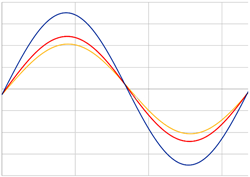Analysis of complex linear periodically time-varying circuits by method of reduced matrix D-trees
DOI:
https://doi.org/10.3103/S0735272723060018Keywords:
periodically time-varying circuits, frequency symbolic method, FSM, periodically time-varying matrix model, d-tree method, matrix d-tree methodAbstract
The paper proposes the method of reduced matrix D-trees, which is an improved version of the method of matrix d-trees. This method is a further development of the application of one of the subcircuit methods, the so-called d-tree method, to the symbolic analysis of linear circuits with constant parameters The method of reduced matrix D-trees, like the d-tree method, provides a significant reduction in the required computer time for modeling circuits, which has a mathematical meaning, consisting in the bringing out of similar terms in the formed complex symbolic expressions. Since there are, in fact, many symbolic terms in such expressions, this reduction in time is due to such factoring. The method is illustrated using a model of a long line consisting of a cascade connection of a large number of elementary links. The results of the computer simulation are also presented.
References
- Y. Shapovalov, Symbolic Analysis of Linear Electrical Circuits in the Frequency Domain. Fixed and Variable Parameters. Lviv: LPNU, 2014.
- Y. Shapovalov, D. Bachyk, K. Detsyk, R. Romaniuk, “Application of the frequency symbolic method for the analysis of linear periodically time-varying circuits,” Prz. Elektrotechniczny, vol. 1, no. 3, pp. 95–99, 2020, doi: https://doi.org/10.15199/48.2020.03.22.
- Y. Shapovalov, D. Bachyk, I. Shapovalov, “Matrix equation of L.A. Zadeh and its application to the analysis of the LPTV circuits,” in 19th International Conference Computational Problems of Electrical Engineering, 2018, pp. 1–5, doi: https://doi.org/10.1109/CPEE.2018.8506766.
- Y. Shapovalov, D. Bachyk, K. Detsyk, R. Romaniuk, I. Shapovalov, “Matrix d-tree method and its application for symbolic analysis of linear periodically time-variable circuits in frequency domain,” Radioelectron. Commun. Syst., vol. 65, no. 9, pp. 485–496, 2022, doi: https://doi.org/10.3103/S0735272722100041.
- Y. Shapovalov, D. Bachyk, K. Detsyk, R. Romaniuk, I. Shapovalov, “Frequency symbolic analysis of linear periodically time-variable circuits by sub-circuits method,” in 2022 23rd International Conference on Computational Problems of Electrical Engineering (CPEE), 2022, pp. 1–5, doi: https://doi.org/10.1109/CPEE56060.2022.9919673.
- Y. Shapovalov, “Analysis of linear periodically time-varying circuits by the frequency symbolic method with applying the D-trees method,” Przegląd Elektrotechniczny, vol. 1, no. 6, pp. 46–53, 2021, doi: https://doi.org/10.15199/48.2021.06.08.
- Y. Shapovalov, D. Bachyk, V. Storozh, K. Detsyk, R. Romaniuk, “Research of long lines with constant and variable parameters using a symbolic method,” in 2021 IEEE 16th International Conference on the Experience of Designing and Application of CAD Systems (CADSM), 2021, pp. 50–53, doi: https://doi.org/10.1109/CADSM52681.2021.9385219.
- B. Ho Eom, P. K. Day, H. G. LeDuc, J. Zmuidzinas, “A wideband, low-noise superconducting amplifier with high dynamic range,” Nat. Phys., vol. 8, no. 8, pp. 623–627, 2012, doi: https://doi.org/10.1038/nphys2356.
- A. Piwowar, D. Grabowski, “Modelling of the first-order time-varying filters with periodically variable coefficients,” Math. Probl. Eng., vol. 2017, pp. 1–7, 2017, doi: https://doi.org/10.1155/2017/9621651.
- P. Vanassche, G. Gielen, W. Sansen, “Symbolic modeling of periodically time-varying systems using harmonic transfer matrices,” IEEE Trans. Comput. Des. Integr. Circuits Syst., vol. 21, no. 9, pp. 1011–1024, 2002, doi: https://doi.org/10.1109/TCAD.2002.801098.
- F. Zhang, Matrix Theory: Basic Results and Techniques. Springer, 2011.
- V. P. Sigorskii, A. I. Petrenko, Fundamentals of Electronic Circuit Theory, [in Russian]. Kiev: Vyssh. Shkola, 1971.
- S. J. Mason, H. J. Zimmermann, Electronic Circuits, Signals, and Systems. New York: Wiley, 1960.
- Y. Shapovalov, D. Bachyk, R. Romaniuk, I. Shapovalov, “Parametric matrix models of parametric circuits and their elements in frequency domain,” Radioelectron. Commun. Syst., vol. 64, no. 8, pp. 413–425, 2021, doi: https://doi.org/10.3103/S0735272721080021.
- Y. Shapovalov, D. Bachyk, K. Detsyk, “Multivariate modelling of the LPTV circuits in the MAOPCs software environment,” Prz. Elektrotechniczny, vol. 98, no. 7, pp. 158–163, 2022, uri: http://pe.org.pl/abstract_pl.php?nid=13088&lang=1.
- Micro-Cap 12: Electronic Circuit Analysis Program. Reference Manual, 11th ed. Sunnyvale, CA: Spectrum Software, 2018.
- Y. O. Koval, L. V. Grinchenko, I. O. Milyutchenko, O. I. Rybin, Foundations of Circuit Theory. Textbook for Students, [in Ukrainian]. Kharkiv: CMIT, 2008.


